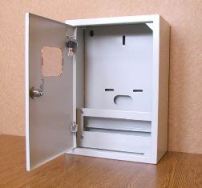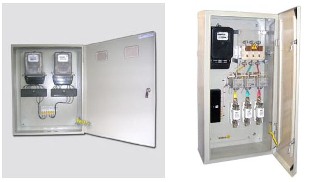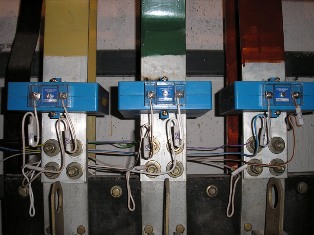Categories: Sharing experience, Electrician Secrets
Number of views: 97,227
Comments on the article: 3
Installation and installation of electric meters
Before installing the meter, you must make wiring diagram. The meter prepared for installation is subjected to external inspection. The counter is cleared of dirt and dust; the suitability of the meter is checked by its type and technical characteristics; the presence of state verification seals on the screws securing the casing is checked.
The seals indicate the year and quarter of state verification, as well as the stigma of the state witness. Installed three-phase meters must have state verification seals no more than 12 months old, the integrity of the casing and glass, the presence of all screws in the junction box, the presence of fixing screws with holes for sealing in the lid of the junction box, the presence of a circuit on its inside should be checked. Here I want to emphasize the following point - purely by chance on the counter there may be a cover from another type of device, therefore I strongly advise you not to navigate only with this circuit!
The counter, like any measuring device, should be protected from shock and shock. They can cause damage to the supports, curvature of the axis and, as a result, an increase in error and even mashing of the moving part. Before installing the meter, make sure that there is no mashing of the moving part. To do this, holding the counter in their hands, they turn around the axis and observe the movement of the disk. The counter should be fastened with three screws, having previously marked the holes for them according to the installation dimensions. After installation, make sure that the counter is strictly upright.
By connecting the wires to the terminals of the meter, it is advisable to leave a margin of 60 - 70 mm. This will make it possible to take measurements with electrical clamps and remount if the circuit is not assembled correctly. A marking tag is put on the end of the wire. As a rule, in accounting systems, current circuits are designated 421, and voltage circuits - 630.
Each wire is clamped in the terminal box of the meter with two screws. First tighten the top screw. By twitching the wires make sure that it is clamped. Then tighten the bottom screw. If the installation is carried out with a stranded wire, then its ends are pressed with ferrules. When installing direct-connected meters, the following rule must be observed - if the rated current of the meter is 20 A or higher, then the connected wires are provided with ferrules to ensure reliable contact.
When installing electrical wiring for connecting direct-connected meters, it is necessary to leave ends of wires with a length of at least 120 mm near the meters.
The insulation of the neutral wire over a length of 100 mm in front of the meter should have a distinctive color. When connecting aluminum wires to the meter, the following rules must be observed: the contact surface of the conductor is cleaned with a steel brush or file and covered with a layer of neutral technical petroleum jelly. Before connecting, the contaminated petroleum jelly is removed from the conductor and now a thin layer of petroleum jelly is again applied instead; the screws are tightened in two steps. First, without jerking, a tightening is performed with the maximum allowable force, then the tightening is greatly weakened (but not completely), after which a secondary, final, tightening is performed with normal force.
Accounting chains are serviced only by personnel assigned to them.
Now let's look at some points with specific examples. To begin with, we dwell on single-phase electricity metering. Until now, especially in rural areas, urban private houses, cottages, etc. apply conventional guards with cartridges for two fusible inserts or automatic "traffic jams".This design for mounting an electric meter is the simplest and cheapest. A stamped sheet of metal, holes for mounting and two cartridges - that's the whole design. True, there is one point - the meter is screwed without a nut on the back side. For this, in the guide grooves cut on the shield, three brackets move, with a thread cut into them. This allows not only to replace the electric meter without dismantling the shield, but also to adjust its position.

But, of course, such guards are increasingly becoming a thing of the past. Now they mainly use cabinets in which they install not only an electric meter, but also protection and switching devices. As a rule, all modern circuit breakers provide for mounting on a DIN rail, which is a necessary attribute of such a cabinet. Not only switching and protection devices are installed on it, but also, for example, a zero bus. You see an example of such a cabinet in the figure. The meter is mounted according to the principle described above. In addition, the cabinet is locked for security. The meter can be read through a transparent window on the front panel. Read how to do it right here: How to correctly take readings from an electricity meter.
Three-phase direct-connected electricity meters are also mounted in appropriate cabinets. Unlike single-phase, they are large in size and also allow you to place various switching devices. In the example shown in the picture, not only electric meters with circuit breakers are placed in the cabinet, but also terminal test boxes, which we talked about in the ninth part of the review.
Now, cabinets with a "free layout" are becoming increasingly popular. A perforated plate (base) is installed in such a cabinet, with holes at regular intervals. Transverse and longitudinal perforated strips are attached to these holes, and DIN rails are already attached to them. From above, the entire structure can be closed with a protective casing. This cabinet design allows you to create absolutely any placement of metering and switching elements, buses, etc.
The examples of installation of electric meters considered by us are related to direct connection schemes. But with indirect or semi-indirect switching on of electricity metering devices, the inclusion circuit includes voltage and current transformers. Below you can see how current transformers are mounted on 0.4 kV buses.
And in conclusion, an example of how you do not need to mount electricity metering, and indeed perform electrical installation. However, this can be found quite often:

Read also:How is the electronic electricity meter arranged and working
See also at bgv.electricianexp.com
:




